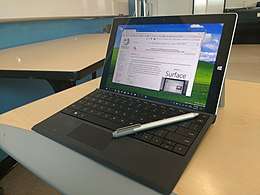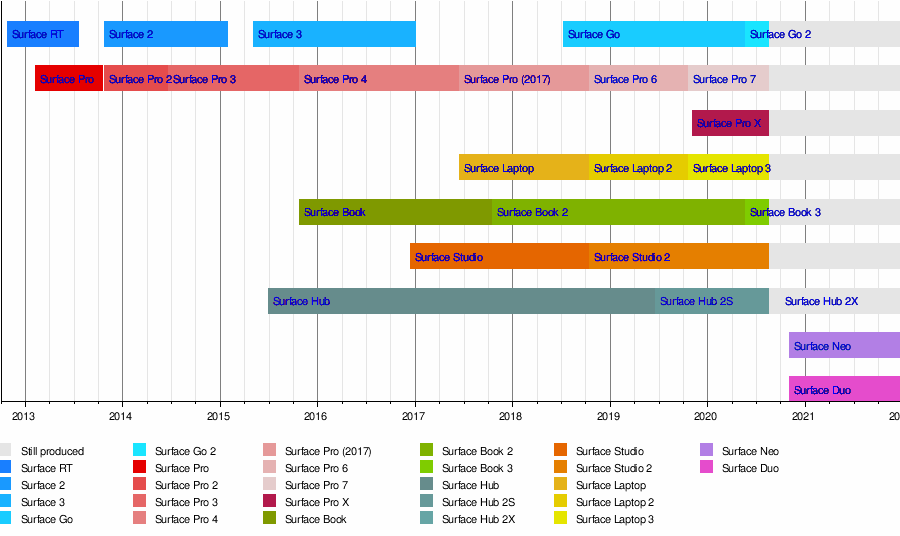Surface 3
Surface 3 is a 2-in-1 detachable from the Microsoft Surface series, unveiled by Microsoft on 31 March 2015 and released on 5 May 2015. Unlike its predecessor, the Surface 2, Surface 3 utilizes an x86 Intel Atom system-on-chip architecture, or SoC, rather than a processor with ARM architecture such as the Nvidia Tegra that powered the Surface 2, and runs Windows 10.[6]
 | |
 Surface 3 with Type Cover and Surface Pen running Windows 10 version 1607 | |
| Developer | Microsoft |
|---|---|
| Manufacturer | Pegatron |
| Product family | Surface |
| Type | 2-in-1 detachable |
| Generation | 3rd |
| Release date | 5 May 2015 |
| Introductory price | $499–599 (USD) |
| Discontinued | late 2016[1] |
| Operating system | |
| System-on-chip used | Intel Atom system-on-chip quad-core x7-Z8700 1.6 up to 2.40 GHz, 2 MB cache, 2 W[2] |
| Memory | 2 or 4 GB LPDDR3 1600 MHz |
| Storage | 64 or 128 GB (37 and 93 GB respectively are user-available)[3] |
| Removable storage | microSD, up to 200 GB[4] |
| Display | 10.8 inches (27 cm): (9 inches (23 cm) by 6 inches (15 cm)) 1920x1280 (214 ppi) ClearType screen with 3:2 aspect ratio |
| Graphics | Intel HD Graphics |
| Sound | Dual front facing speakers |
| Input | Multi-touch touchscreen Bluetooth active pen, with underlying N-trig DuoSense technology (sold separately) Type Cover detachable keyboard with touchpad (sold separately) |
| Camera | Front: 3.5 MP, 1080p HD Rear: 8 MP, 1080p HD |
| Touchpad | On the Surface Type Cover (sold separately) |
| Connectivity | Wireless: 802.11 a/b/g/n/ac Wi-Fi Bluetooth 4.0 LE Ports: Full size USB 3.0 Mini DisplayPort 3.5 mm audio socket Cover port (proprietary) Charging/Docking port (Micro-USB) 4G LTE (with cellular model) |
| Power | Battery 3.78V 27.5Wh/7270mAh charger 5.2V 2.5A (13W) |
| Online services | Windows Store, OneDrive, Xbox Music, Xbox Games, Xbox Video |
| Dimensions | 10.51 inches (267 mm) (width) 7.36 inches (187 mm) (height) 0.34 inches (8.6 mm) (depth) |
| Mass | 1.37 pounds (620 g) 0.58 pounds (265 g) (add for Type Cover)[5] |
| Predecessor | Surface 2 |
| Successor | Surface Go |
| Related articles | Surface |
| Website | www |
| This article is part of a series on |
| Microsoft Surface |
|---|
History
The older, original Surface (also known as Surface RT) and Surface 2, with their ARM-based processors and Windows RT operating system, are pitched against the iPad and other tablets. The first Surface was criticized for performance issues though this was rectified in the succeeding Surface 2. The biggest problem was that these ARM-powered devices were incompatible with the vast number of programs written for x86 personal computers, while suffering from the limitations of the Windows RT operating system and its sparse application ecosystem.
Released prior to Surface 3, the Surface Pro 3 (featuring a more powerful Intel Core processor) became a profitable business for Microsoft in late 2014.[7] It had a starting price of $799, features a high-resolution ClearType display[8] and competes with high-end ultraportable laptops like the Apple MacBook Air and other Ultrabooks.[9][10][11]
With the introduction of the Surface 3, Microsoft aims to make the Surface more affordable for those who don't need the power of the Surface Pro 3, at the expense of some performance. Surface 3 can be considered a closer competitor to traditional tablets like Apple iPad, with Surface 3 offering full desktop OS capabilities instead of a tablet's mobile OS.
Features
Hardware
The Surface 3 share a similar design to the Surface Pro 3 with a body made of magnesium alloy giving a matte gray finish to the back of the device. It features a kickstand that can be set to three different angles: 22, 44, and 60 degrees. The Surface 3 does not have a fan, therefore lacking the ventilation holes seen on Surface Pro line. The Surface 3 weighs 620 grams features a 10.8 inches (27 cm) diagonal multi-touch display with a 3:2 aspect ratio. For a charger Surface 3 uses a standard Micro-USB, giving users a wider variety of charging options, including charging the device with a mobile phone charger.
Surface 3 has the 14 nm quad-core Intel Atom x7-Z8700 SoC.[12] The Atom x7-Z8700 is able to drive up to three external displays over Mini DisplayPort and support a resolution of up to 4K with a single external display.[13] The 2-in-1's own display has a resolution of 1920x1280. The device ships with either a 64 or 128 GB solid-state drive and 2 or 4 GB of system memory.[14] The device's storage capacity can be increased by installing a microSD memory card of up to 200 GB.
Software
Unlike its predecessors, the Surface 3 is the first device in the non-Pro line to feature the full Windows desktop OS as opposed to Windows RT. This therefore puts the device into the category of 2-in-1 PC, which cannot be said for its predecessors, the original Surface and Surface 2, due to their use of ARM processors.
Surface 3s purchased before 29 July 2015 come with Windows 8.1 but are upgradeable to Windows 10 for free from that date onwards.[15] Since the Windows 10 release, consumer models of the Surface 3 now ship with Windows 10 Home, unlike the devices of the Surface Pro line, which ship with Windows 10 Pro. Business models of the Surface 3, however, now ship with Windows 10 Pro.[16][15]
Accessories

The Surface 3, as with its predecessors and Surface devices of a Pro line, features an optional Type Cover accessory—an attachable keyboard, which is also a protective cover for the screen, with an announced price of 129 USD.[17]
The Surface 3 is the first non-Pro Surface to feature a pen digitizer and hence supports the Surface Pen. Unlike Surface Pro 3, however, it is not included in the box, but is available for purchase separately.
Various aftermarket USB or Bluetooth peripheral devices, such as keyboards and mice can be connected to the Surface 3.
Reception
Surface 3 received generally positive reviews from computer critics. They praised Microsoft's shift from ARM architecture toward x86, and therefore from Windows RT to a regular Windows OS. Most noted a well designed chassis and accessories produced of quality materials, and overall premium feeling of use. While less powerful, the Surface 3 was a lighter and cheaper alternative to the Surface Pro 3. More importantly, the Surface 3 could compete at the high-end of Android and iPad tablets, with the advantage of being a device running a full desktop OS instead of a mobile OS for a similar price.[18] Reviewers also note that 37 GB[3] of the total storage space in the low-end Surface 3 is available to the user, while its close competitor, the low-end iPad Air 2, has only 12.5 GB of user-available storage space for the same price.[12][19]
The most common downsides are relatively low battery life, slower performance compared to devices with Intel Core processors[19][20] and a high price since accessories like Surface Pen and Type Cover are not included.[19][21][18]
Timeline

References
- Statt, Nick (24 June 2016). "Microsoft to end production on the Surface 3 by late 2016". The Verge. Retrieved 26 June 2017.
- ARK | Intel® Atom™ x7-Z8700 Processor (2M Cache, up to 2.40 GHz). Ark.intel.com. Retrieved on 2015-10-31.
- "Surface storage". Microsoft.com. Retrieved 21 July 2015.
- "World's Highest Capacity microSD™ Card". SanDisk.com. Retrieved 12 May 2015.
- "Surface Accessories: Tablet Accessories, Keyboards, Cases & More - Microsoft Store". www.microsoftstore.com. Retrieved 26 June 2017.
- "Microsoft's Surface 3 is a $499 tablet that could be a full Windows laptop". The Verge. Retrieved 31 March 2015.
- Keizer, Gregg. "Microsoft's Surface line-up posts 2nd straight profitable quarter". computerworld.com. Retrieved 26 June 2017.
- "Surface Pro 3 Fact Sheet" (PDF). Microsoft. May 2014. Retrieved 7 December 2015.
- Pogue, David (22 May 2014). "Smart, Versatile Surface Pro 3 Can Do It All — Maybe Even Lift the Windows 8 Curse". Yahoo Tech. Yahoo. Archived from the original on 23 May 2014. Retrieved 24 May 2014.
- Bohn, Dieter (23 May 2014). "Microsoft Surface Pro 3 review". The Verge. Vox Media. Retrieved 24 May 2014.
- Eadicicco, Lisa. "POGUE: The Surface Pro 3 Is The One Time Windows 8 Isn't A Disaster". Business Insider. Retrieved 24 May 2014.
- Keizer, Gregg (3 April 2015). "Benchmark scores show performance gap between Surface 3 and Surface Pro 3, iPad Air 2". ComputerWorld.com. Retrieved 6 April 2015.
- "Intel Atom x7 microprocessors". CPU-World.com. Archived from the original on 7 April 2015. Retrieved 2 April 2015.
- "Introducing Surface 3". Microsoft.com. Retrieved 2 April 2015.
- Panay, Panos (31 March 2015). "Announcing Surface 3". Archived from the original on 24 July 2015. Retrieved 23 July 2015.
- Callaham, John (4 August 2015). "Windows 10 is now pre-installed when you buy Surface 3 and Surface Pro 3 tablets". Windows Central. Mobile Nations. Retrieved 3 December 2015.
- Lendino, Jamie (31 March 2015). "Microsoft unveils $499 Surface 3 tablet running real Windows". Retrieved 2 April 2015.
- Hardawar, Devindra (15 April 2015). "Surface 3 review: Finally, a cheap Surface you'd actually want". Engadget.com. Retrieved 8 June 2015.
- Smith, Matt. "The new Surface 3 runs full-blown Windows 8.1 just like its Pro sibling". DigitalTrends.com. Retrieved 8 June 2015.
- Martin, Jim (12 May 2015). "Microsoft Surface 3 review: cheaper but not better than the Surface Pro 3". PCAdvisor.co.uk. Retrieved 12 June 2015.
- Howse, Brett (4 May 2015). "The Surface 3 Review". AnadTech.com. Retrieved 8 June 2015.
.svg.png)